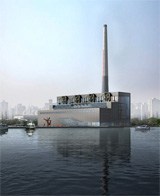The site of the Shanghai Biennale will move from the colonial building of Shanghai Art Museum that was part of the Shanghai Horseracing Course to a restored building that once was “Nanshi Power Plant”. As we are witnessing a shift of the nation’s attention from economic indicators to comprehensive social progress, the Shanghai Biennale has also seen transformations in its theme, which include:
- Transformation from an experimental ground for various contemporary art media to a provider of solutions for social problems;
- Transformation from focusing on building the right cultural infrastructure to the rebirth of a truly contemporary culture;
- Transformation from learning from international biennales to actively engaging in finding solutions for international cultural predicament.
Shanghai Contemporary Art Museum sits in an old industrial cluster that was the birthplace of Chinese modern industry. The building served as the venue for the impressive theme pavilion of “Pavilion of Future” during 2010 Shanghai World Expo. The cultural heritage of the building can be linked to a series of topics such as the past, the future and rebirth, showcasing the profound interaction between various historical forces.
Like other restoring projects for industrial sites, the thermal plant building restoration aims to more than reuse old resources and tries to contribute to the rethinking and redesign of the entire urban ecosystem. Cities are places for people to lead a gregarious life, as we all wish to communicate with other people. After hundreds of years of industrial development, cities are renewing themselves each and every day. They import and consume energy and export it at the same time.
Cities in 2012 are hubs for the integration of and exchanges between human and natural resources and information as well as spaces for people to converse, interact and mingle. Individuals with different identities, memoires and sensibilities become a collective entity and build the so-called “society”. Such a collective will is the most important factor for the survival of a city.


